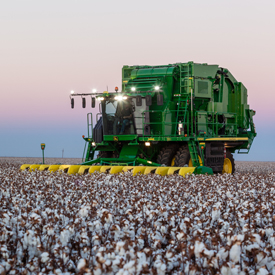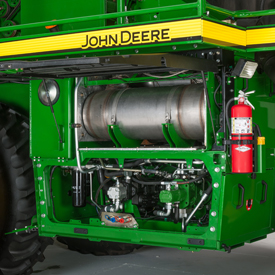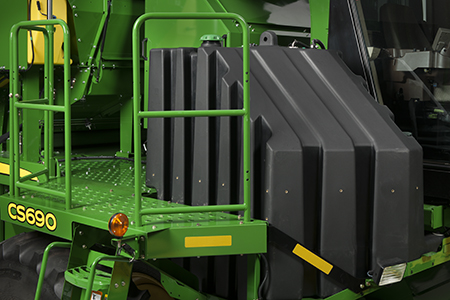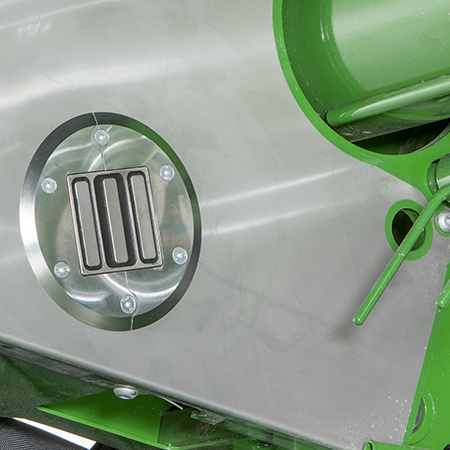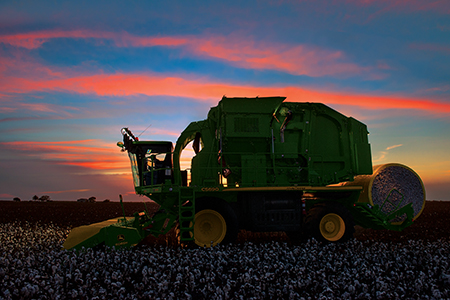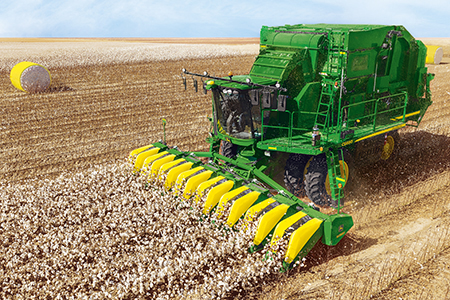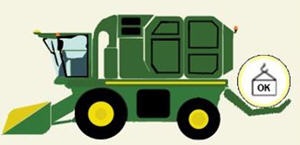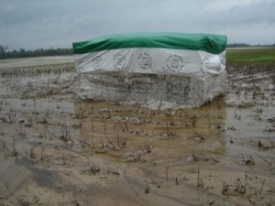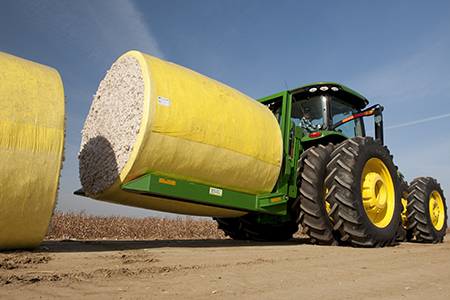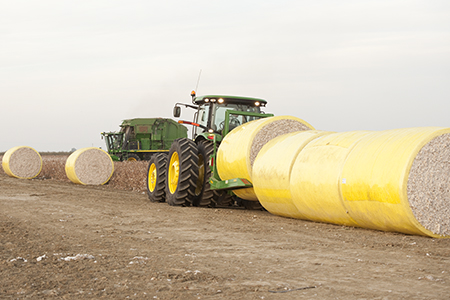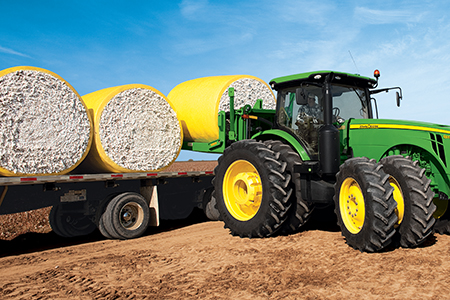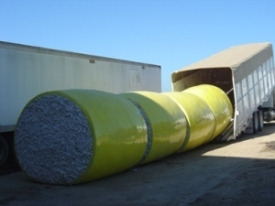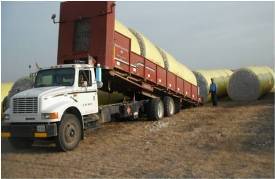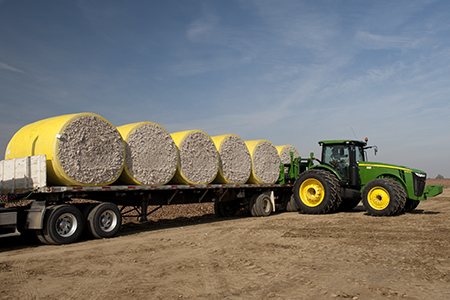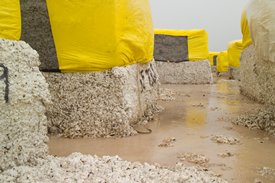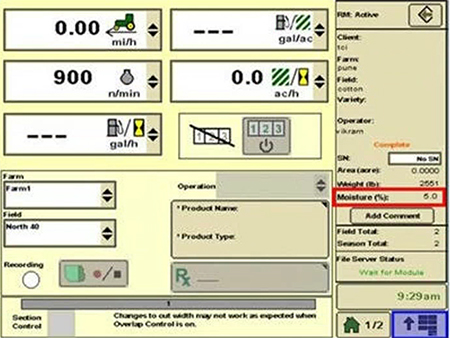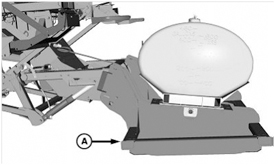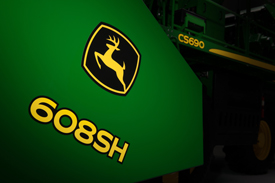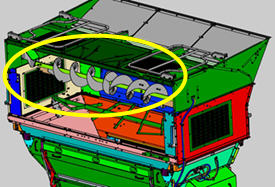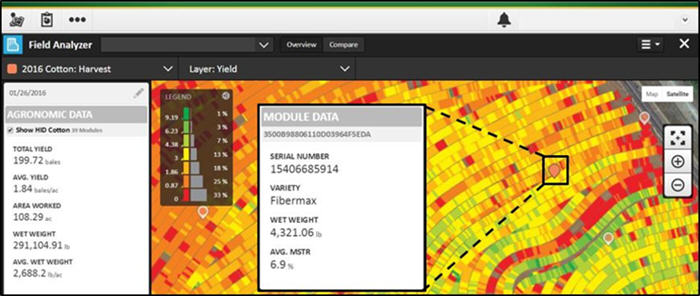 Round module information displayed in John Deere Operations Center Field Analyzer
Round module information displayed in John Deere Operations Center Field Analyzer
Harvest Identification, Cotton Pro is the next generation of round module tracking. Features include the documentation of module moisture, weight, editable comments, and other features listed below. Harvest Identification, Cotton Pro links to John Deere Operations Center Field Analyzer tool to visually display module created locations on the yield map along with providing individual module information.
More information about the integration of Harvest Identification, Cotton Pro with John Deere Operations Center is available here.
Operators have multiple options in choosing when to send Harvest Identification, Cotton Pro files from their display to the Operations Center. Choose between the Send Files button on the run page of the display, allowing operators to send files via JDLink© Connect with Wireless Data Transfer (WDT) and pre-established send times on the setup tab. See below for more detail on these options.
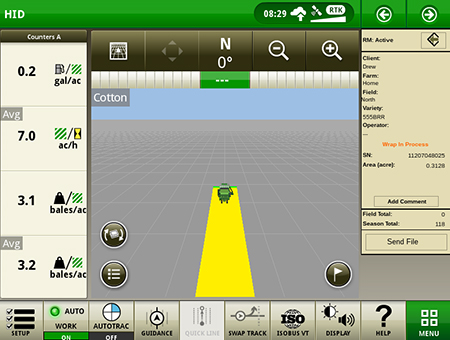 Send Files button allows operators to share information
Send Files button allows operators to share information
Another option the operator has is to send files automatically at three different times during the day, which are selected by the operator in the Harvest ID, Cotton Pro setup tab.
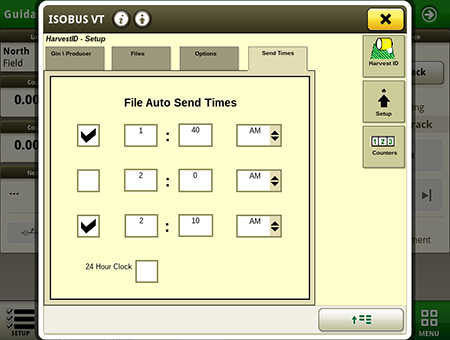 Automatically send files via the setup tab
Automatically send files via the setup tab
Harvest Identification, Cotton Pro monitor
Harvest Identification, Cotton Pro incorporates features that allow producers to better manage their cotton harvest data for agronomic decisions. Expanded operational features on the GreenStar 3 2630 or Gen 4 4640 Universal Display include automatic module serial number, module notifications, comments, module history, field file sorting, and season counter reset.
The automatic module serial number feature will fill in a missed module serial number if the radio frequency identification (RFID) tag did not document in the Harvest Identification, Cotton Pro monitor and file. This feature reads the previous module serial number and the serial number of the module after the missed module and automatically completes the missing serial number if it detects sequential serial numbers. In addition to the automatic serial number feature, the serial number field on the display is editable, allowing the operator to add a serial number manually.
Module notifications alert the operator of missing RFID data and potential data loss so the information can be captured and documented while the module is displayed on the GreenStar 3 2630 or Gen 4 4640 Universal Display. This feature allows the information coming from the harvester to John Deere Operations Center to be complete removing the need to correct data later.
Operators have the ability to add comments to modules in the GreenStar 3 2630 or Gen 4 4640 Universal Display while harvesting. This capability allows the producer to manage modules that have a comment and can be used to alert ginners of something specific to the module.
Harvest Identification, Cotton Pro allows operators to view three modules on the GreenStar 3 2630 or Gen 4 4640 Universal Display at one time. This flexibility allows the operator to make comments and compare module information while harvesting in the field.
Producers have the flexibility of creating specific Harvest Identification, Cotton Pro files to meet their needs. A producer can create any one or multiples of the following files: master data file (standard), client data file, field data file, producer ID data file, and gin ID data file. These files allow a producer to manage data for custom harvest producers, by the field, by producer ID, and/or by gin ID. These files shorten the time a producer spends reviewing data.
Harvest Identification, Cotton Pro theory of operation
The backbone of John Deere Harvest Identification, Cotton Pro is the RFID tag chip found in each portion of Tama RMW© cotton wrap. This module wrap is currently produced with Impinj® Monza® RFID tag chips embedded in the polyurethane material.
These RFID tag chips give each round module the ability to be recorded and processed as single entities. With this unique characteristic, producers and ginners can generate more specific reports, which could define and link attributes to a production area.
Advantages of linking crop characteristics to a production area:
- Ability to see exactly what crop quality a particular section of the field produced
- Finely adjust application rates or even trace back high leaf grades to defoliation problems
Producers need this type of information to more precisely select varieties with characteristics that would allow them to gain the most value out of their land. Harvest Identification, Cotton Pro is the building block to these ideas.
The information found in the Harvest Identification file includes data relevant to both a producer’s documentation requirements and their ginner’s record keeping system. Data files can be transferred from the machine automatically with Wireless Data Transfer (WDT) included in a JDLink Connect subscription or manually using a USB stick. The chart shows what is automatically entered into Harvest Identification, Cotton Pro and what information is populated through operator input, given that a StarFire© receiver is installed.
John Deere Harvest Identification, Cotton Pro file inputs |
Automatically populated fields |
Operator populated fields |
| Module identification number |
Client* |
| Module serial number |
Farm* |
| Module created Latitude |
Field* |
| Module created Longitude |
Variety* |
| GMT date |
Operator |
| GMT time |
Gin ID |
| Machine serial number |
Producer ID |
| Local time |
|
| Field area |
|
| Season total |
|
| Module diameter |
|
| Module moisture |
|
| Module weight |
|
| Module drop latitude |
|
| Module drop longitude |
|
| Field total |
|
| Incremental area |
|
| Local date |
|
| Comments |
|
*Fields will be populated automatically if information is preloaded into the display before season and Field Locator is selected.
Module identification (ID) number
The module ID number is used to uniquely identify one module from another. By giving each round module a unique ID number, every module produced has its own description and attributes associated to it. This provides value chain partners the ability to dig deeper into the why and how as it pertains to the production cycle and its effect on quality and output.
Module serial number
The module serial number (SN) is used to give a historical account for each portion of the Tama RMW. This number is used to identify each portion’s year of production, manufacturing location, and production machine.
Module moisture
Individual module moisture is documented for traceability to the producer and ginner. Module moisture is closely tied to cotton quality which helps the producer know when to start and stop harvesting during their harvest day. Ginners can prioritize ginning for modules with high moisture to preserve both fiber and seed quality.
Module weight
Producers can track individual module weights which eases infield yield monitor calibration. Ginners will appreciate the individual weights for their records, specifically gins without scales.
Incremental area
Incremental area provides the producer measured area between round modules. This area provides increments in the field that can be used to identify opportunities in a particular production zone within the field.
Comments
Harvest Identification, Cotton Pro offers producers the capability to add notes to each individual module from the display. This field displays any comments the operator adds while harvesting which can be used by the producer or ginner to track specific modules if needed.
Module created latitude and longitude
These fields provide coordinates on where the module was created, module wrapped, in the machines round module chamber. These two positions help producers identify and/or highlight particular production zones within their operation.
Module drop latitude and longitude
These fields provide coordinates on where the module was dropped in the field to better coordinate module staging activities.
GMT date and time
The GMT time and date was chosen as a global input to represent date and time of module formation.
From the producer’s standpoint
John Deere Harvest Identification, Cotton Pro provides the ability to track and record module formation as it occurs in the field. When a module is unloaded from the machine’s round module chamber, its information is sent to a controller by a specifically designed RFID reader. Here the data is compiled with the operator’s production inputs giving the module its unique identity. With this information, producers can isolate round cotton modules based on fields or specific production areas. Once defined, location coordinates can be used to correlate applied inputs to yield performance. Producers do not have this degree of traceability with traditional basket systems, as multiple machines could be feeding one module builder; mixing cotton from multiple field sites into large traditional modules. It is almost impossible to look at characteristics on a per acre basis this way.
Cotton producers have asked for another way to track and tag modules without having to manually go to each individually in the field. Harvest Identification, Cotton Pro gives producers a unique and efficient way to record information from modules one-fourth the size of traditional modules, and it is all done from the machine’s operator seat. Also, with Harvest Identification, Cotton Pro, a producer does not have to wonder how many modules were made in each field. The machine collects that information while also connecting module identification numbers to producer defined inputs; populating a data file that not only can be used for yearly production records but can also be sent to gins as a harvest report.
From the ginner’s standpoint
John Deere Harvest Identification, Cotton Pro provides an avenue for a more robust module tracking and logistical system. By incorporating Harvest Identification, Cotton Pro into the ginning process and utilizing an electronic booking system, organizations will see efficiency increases throughout their operation. From the way production information is entered on the producer side to how gin managers initiate module transport; ginners will see a dramatic improvement in their day-to-day operation.
One part of the system is the actual Harvest Identification file that is sent from the producer to the gin. The other important piece is the RFID tag found in the wrap portions. RFID is a leading technology in inventory tracking/verification, as it provides the ability to record real-time activity and product movement. As a wireless non-contact use of radio-frequency electromagnetic fields, any object with an RFID tag chip has the ability to be recorded using RFID readers and antennas.
Like most businesses, cotton gins have product that is constantly moving from one place to another.
RFID technology is starting to take the place of the common barcode system as a more efficient and user-friendly way to track inventory. One of the biggest advantages of RFID tracking is the ability to read tags that are not within a line-of-sight or that may be imbedded within an object. When trying to implement an RFID system, the user needs three basic parts: a tag chip, reader hardware, and the supporting software to translate data into a useable format.
From the simple advantage of recording modules as they are made to gins building robust RFID-based tracking systems, the need to know more is beginning to show itself in the cotton industry.
Impinj and Monza are trademarks of Impinj, Inc. Tama RMW is a trademark of Tama Plastic Industry.




